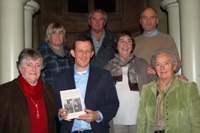Disappeared world

Pictured are Dr Bleddyn Huws with members of the Carneddog and Gwallter Llyfni families at the book launch.
01 December 2010
Hot off the press is a publication from the Department of Welsh, a book edited by Dr Bleddyn Huws, Diflanedig Fyd: Gohebiaeth Carneddog a Gwallter Llyfni, 1926-1932 (Disappearing World: The Correspondence of Carneddog and Gwallter Llyfni, 1926-1932). To celebrate the launch of the publication at the Old College, Dr Huws was presented with a copy of the book by Mr Dafydd Pritchard on behalf of the publishers, Cyhoeddiadau Barddas.
The book, which is the outcome of a research project within the Department of Welsh, contains letters between folk poets and writers from Snowdonia. A former research student of the Department, Dr Gwen Angharad Gruffydd, who currently works for the Centre for Advanced Welsh and Celtic Studies in Aberystwyth, was responsible for the transcription of the correspondence between Carneddog and his contemporaries, Bob Owen Croesor, J.W. Jones Blaenau Ffestiniog and O.M. Edwards. The correspondence between Carneddog and Gwallter Llyfni gives an invaluable insight into the social history of these cultured men and their literary interests.
Professor Patrick Sims-Williams, Head of the Department of Welsh, welcomed members of the families of Carneddog and Gwallter to the book launch. In their midst were Mr Glyn Jones, Gwallter Llyfni’s great nephew, and Mrs Heulwen Jones and Mrs Jean Powell Jones, both descendants of the Carneddi family of Nanmor. During the launch, extracts from the letters were read out by Dr Huws and his colleague Dr Huw Edwards.
Whilst discussing the content of the book, Dr Bleddyn Huws said: “This correspondence is between two folk poets and writers who greatly cherished Welsh poetry and culture. Their letters shed interesting light on the life and times in Wales during the inter-war years. They discuss various subjects such as the state of religion, politics, eisteddfodau and the unique Welsh folk culture and literature. In addition we also learn of the true friendship that existed between these two characters whose company is worth keeping.”



